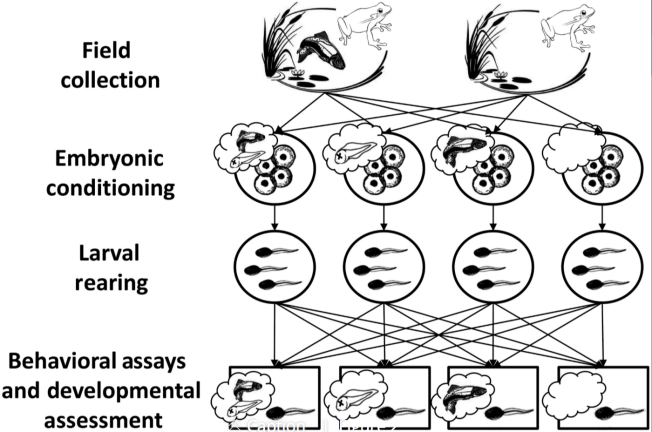At a young school child (so long ago I can’t recall exactly when) I was exposed to Ernst Haeckel’s dictum that “ontogeny recapitulates phylogeny.” More interested in language than biology at the time, I thought “cool – three words that I’m clueless about.” Though biological thinking about ontogeny – the processes of growth and development – has changed since Haeckel’s time, interest has, if anything, grown more intense across disciplines. Tiffany Garcia has explored her lifelong fascination with ontogeny by focusing her research on amphibians, which are famous for their distinct stages of development, each with unique habitats and ecological requirements. Working with eggs and tadpoles of the Pacific chorus frog (Pseudacris regilla), Garcia and her colleagues investigated whether stress associated with the presence of predators during one developmental stage (for example an egg) would carry over to influence behavior or development of subsequent stages.

The Pacific chorus frog (Pseudacris regilla). Credit Brett Hanshew.
A tadpole’s anti-predator strategy can be influenced by other factors besides carry-over from earlier developmental stages. For example, we might expect that tadpoles whose ancestors lived in association with predators for many generations might have evolved a different anti-predator strategy than did tadpoles whose ancestors lived in a less threatening environment (this would be an adaptive effect). Tadpoles may also show very short-term changes in behavior or development (this is termed plasticity) if exposed to a cue that indicated a possible predation threat.

Collecting newly laid eggs at Three Creeks Lake. Credit: Lindsey Thurman
These three processes operate over very different time scales (long term – adaptive; intermediate term – carry-over; short term – plastic). Garcia and her colleagues designed an experiment to explore how these processes might interact to influence a tadpole’s anti-predator strategy. To investigate long term adaptive effects, the researchers collected newly laid (fertilized) eggs from lakes with and without rainbow trout (Oncorhynchus mykiss). They investigated carry-over effects by conditioning these eggs with four different environments during development: (1) trout odor, (2) cues from injured tadpoles (alarm cues), (3) trout odor paired with alarm cues, and (4) a water control (no odors nor cues). The researchers created alarm cues by grinding up four juvenile tadpoles in 150 ml of water, and trout odor by housing 30 juvenile rainbow trout in a 200 L tank filled with well water. They then conducted behavioral and developmental assays on tadpoles to see how adaptive, carry-over and plastic effects influenced tadpole growth, development and behavior.

Overview of the experimental design.
Garcia and her colleagues discovered that early exposure to trout odor had very little effect on growth and development, with body size and stage of development equivalent to that of controls. In contrast exposure of eggs to tadpole alarm cues or to alarm cues + trout odor resulted in smaller, less developed fish (see table below). In addition there was no effect of evolutionary history – eggs from lakes with and without trout showed similar patterns of growth and development.

Tadpole size and development in response to the four conditioning treatments. Higher Gosner stage numbers indicated more developed tadpoles. A tadpole hatches at Gosner stage 21 and begins metamorphosis at Gosner stage 42.
The next question is how do tadpoles respond behaviorally from exposure to different environments over the long, intermediate and short time scale? To test tadpole anti-predator behavior, the researchers placed an individual tadpole into a tub that had a 6 X 8 cm piece of corrugated black plastic, which the tadpole could use as a refuge. The researchers added to each tub one of the following: water (as a control (C)), tadpole alarm cues (AC), trout odor (TO), or alarm cues + trout odor (AC+TO). After an acclimation period, a researcher noted the position of the tadpole (under the refuge or out in the open) every 20 minutes over a 3-hour time period.
There were no effects of evolutionary history on refuge use. Tadpoles from lakes with and without trout showed similar patterns of refuge use. However, embryonic conditioning to alarm cues and trout odor had a large effect on refuge use. The left graph below shows the response of tadpoles from all four conditioning groups (C, AC, TO and TO+AC) to the addition of water. As you can see, tadpoles that hatched from eggs that were conditioned with AC+TO were most likely to use refuges, while tadpoles from AC only or TO only eggs were somewhat more likely to use refuges. The pattern repeats itself when tadpole alarm cues are added to the water (second graph from left). However when trout odor is added to the water, the responses are much more extreme, but follow the same pattern (third graph). Lastly, when confronted with alarm cues and trout odor, tadpoles increase refuge use dramatically, but again show the same pattern, with tadpoles from control eggs using refuges the least, and tadpoles from eggs conditioned with alarm cues and trout odor using refuges the most (right graph).

Refuge use by tadpoles in response to embryonic conditioning and experimental exposure. C = water control, AC = tadpole alarm cue, TO = trout odor, and AC+TO = tadpole alarm cue and trout odor. Blue bars are means and gray bars are 95% confidence intervals.
There are two processes going on here. First, over the short term, tadpoles are more responsive to the strongest cues, increasing refuge use when exposed to both tadpole alarm cues and trout odor. Second, over the intermediate term, there is solid evidence for carry over effects. Tadpoles that hatched from eggs conditioned with alarm cues and/or trout odor showed markedly increased refuge use than did tadpoles that hatched from control eggs.
These predator-induced responses impose a cost to the tadpoles. Tadpoles exposed to alarm cues and trout odor while still in the egg were smaller and less developed, and probably metamorphosed into smaller frogs. Many studies have shown that smaller frogs have reduced reproductive success. The researchers recommend further studies to explore these trade-offs between survivorship, growth rate, development rate and size at metamorphosis. These studies are particularly essential, because rainbow trout are a non-native predator to these lakes. Studies such as these allow conservation ecologists to understand the evolution and development of predator-prey interactions when novel species are introduced into an ecosystem.
note: the paper that describes this research is from the journal Ecology. The reference is Garcia, T. S., Bredeweg, E. M., Urbina, J., and Ferrari, M. C. O.. 2019. Evaluating adaptive, carry‐over, and plastic antipredator responses across a temporal gradient in Pacific chorus frogs. Ecology 100( 11):e02825. 10.1002/ecy.2825. Thanks to the Ecological Society of America for allowing me to use figures from the paper. Copyright © 2019 by the Ecological Society of America. All rights reserved.
